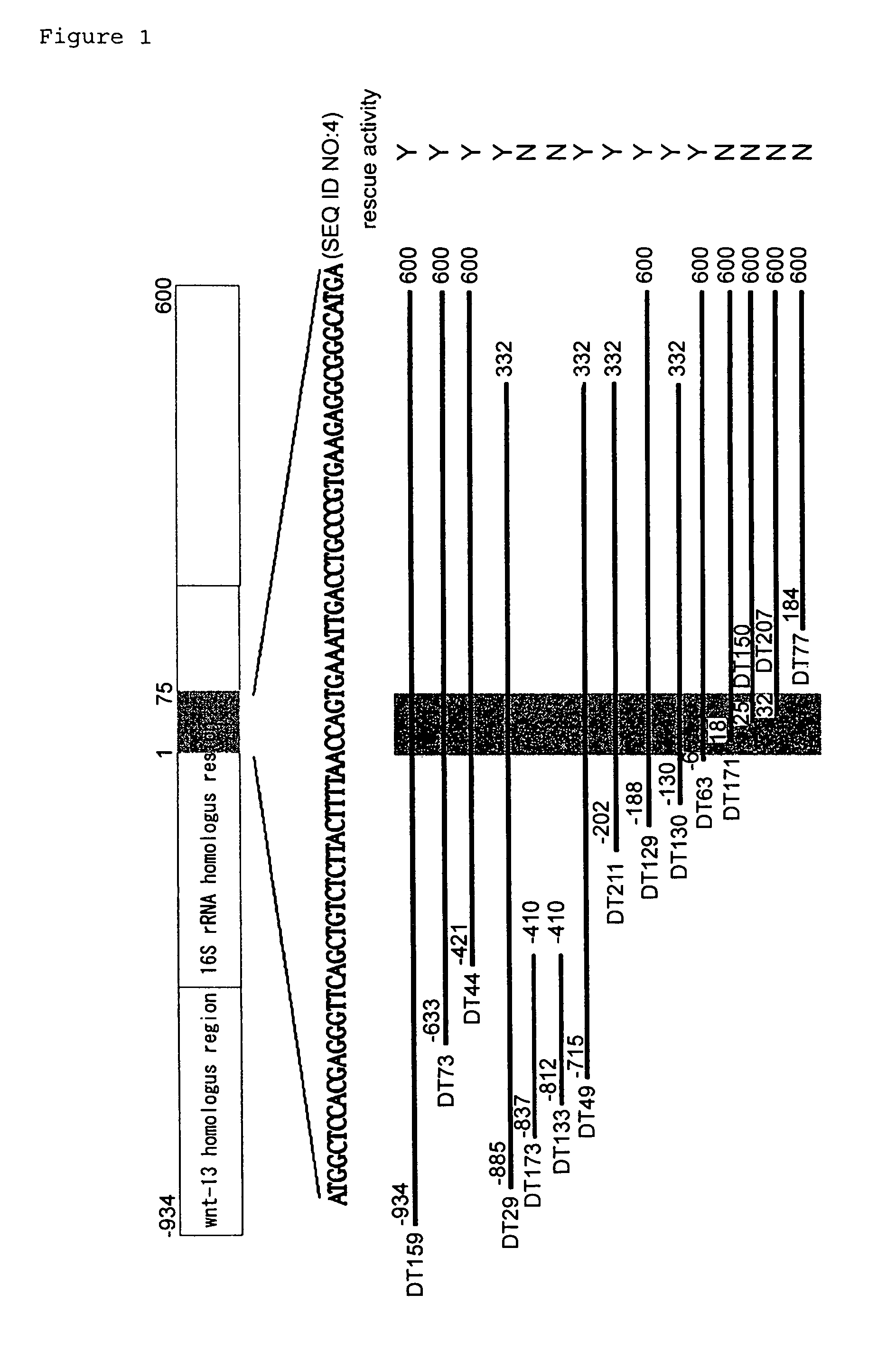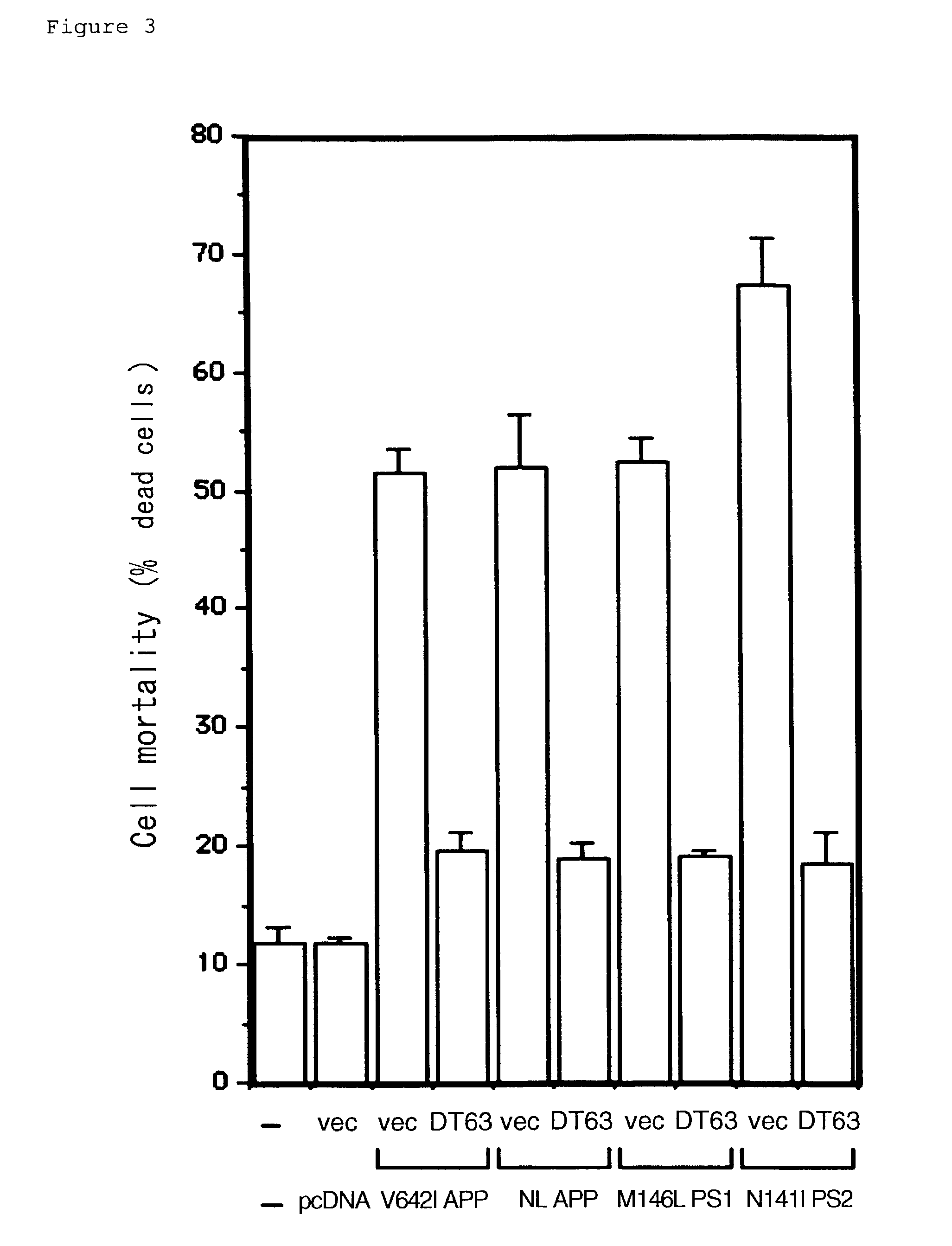Method of screening disease depressant gene
a disease depressant and gene technology, applied in the field of screening for a disorder suppressor gene or a disorder suppressor polypeptide, can solve the problems that diseased organs and tissues may not be suitable for screening, and no effective therapy has so far been established, and achieve the effect of efficient screening
- Summary
- Abstract
- Description
- Claims
- Application Information
AI Technical Summary
Benefits of technology
Problems solved by technology
Method used
Image
Examples
example 1
Construction of cDNA Expression Library
[0120]According to the guidelines of the research institute, poly(A)+RNA was extracted from a brain sample (occipital cortex) of a patient who was diagnosed through a biopsy to have sporadic Alzheimer's disease; the extracted poly(A)+RNA was incorporated into an expression vector to construct a cDNA expression library. As the expression vector, the mammalian cell expression vector pEF-BOS having the elongation factor promoter (Mizushima and Nagata, 1990, Nucleic Acids Res. 18: 5322) was used. Poly(A)+ RNA was reversely transcribed using a modified oligo-dT primer containing NotI site. Double-stranded cDNA was ligated with EcoRI-BstXI adaptor primers (5′-pGAA TTC ACC ACA-3′ and 3′-CTT AAG GTGp-5′), and cleaved with NotI. After removing low molecular weight DNA, the cDNA was ligated with BstXI-NotI fragment of pEF-BOS, and transferred into the XL1 Blue MRF′ strain by electroporation. The primary library size and the mean size of insert were 3.2×1...
example 2
Identification of Humanin
[0121]The F11 cell, established by fusing E17.5 rat primary cultured neurons and mouse neuroblastoma NTG18, is an immortalized cell model of primary cultured neurons (Platika, D. et al. (1985) Proc. Natl. Acad. Sci. U.S.A. 82, 3499-3503). Without a differentiation stimulus, the cell maintains typical characteristics of primary cultured neurons, such as the production of an activation potential (Platika, D. et al. (1985) Proc. Natl. Acad. Sci. U.S.A. 82, 3499-3503). The present inventor discovered that upon transfection of F11 cells with cDNA encoding V642I / F / G APP, i.e. three kinds of FAD causative genes, transient expression of V642 mutant APP causes cell death (Yamatsuji, T. et al. (1996) Science 272, 1349-1352). Accordingly, the present inventor used the recently developed ecdysone-inducible system (No, D. et al. (1996) Proc. Natl. Acad. Sci. U.S.A. 93, 3346-51) to construct F11 clones wherein the V642I APP is inducible. F11 cells wherein the expression o...
example 3
Suppressive Effect of Respective Clones on Cell Death Induced by FAD Genes
[0124]FIGS. 2 to 4 demonstrate the effects of co-transfection of respective clones belonging to this group. When F11 / EcR cells (F11 clone stably expressing EcR and RXR, wherein the expression of genes encoded by pIND plasmid are induced by ecdysone) were transiently transfected with pIND encoding V642I APP in the absence of ecdysone (non-V642I APP inducing conditions), 72 hours later, cell death occurred in about 20% of the cells, whereas cell death occurred in a significantly high proportion (50 to 60%) of cells in the presence of ecdysone (V642I APP inducing conditions) (FIG. 2). F11 / EcR cells transfected with DT63-encoding PEF-BOS, in addition to V642I APP-encoding pIND, demonstrated no significant increase of cell death induced by ecdysone even in the presence of ecdysone. On the other hand, cells transfected with PEF-BOS or pEF-BOS encoding DT171, demonstrated significant increase in cell death in respons...
PUM
| Property | Measurement | Unit |
|---|---|---|
| volume | aaaaa | aaaaa |
| molecular weight | aaaaa | aaaaa |
| molecular weight | aaaaa | aaaaa |
Abstract
Description
Claims
Application Information
 Login to View More
Login to View More - R&D
- Intellectual Property
- Life Sciences
- Materials
- Tech Scout
- Unparalleled Data Quality
- Higher Quality Content
- 60% Fewer Hallucinations
Browse by: Latest US Patents, China's latest patents, Technical Efficacy Thesaurus, Application Domain, Technology Topic, Popular Technical Reports.
© 2025 PatSnap. All rights reserved.Legal|Privacy policy|Modern Slavery Act Transparency Statement|Sitemap|About US| Contact US: help@patsnap.com



